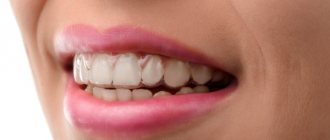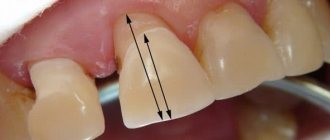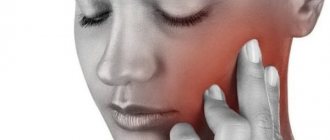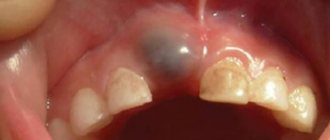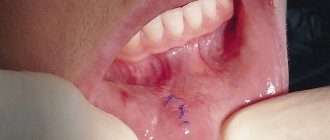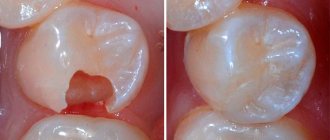18443
A cyst is the appearance of a small round formation with purulent masses near the apex of the tooth root, which is limited by the fibrous membrane.
infection entering the root canal after poor treatment or various injuries and some dental diseases.
In what cases can self-treatment be used?
To deal with tooth decay on your own, you must first consult a doctor. Treatment at home should be carried out after approval of the funds by a specialist. Otherwise, you risk making the problem worse. Because of this, complex surgical intervention will be required in the future.
Prevents infection and further suppuration.
Doctors say that folk remedies for treating cysts are effective only in complex therapy. They provide an anti-inflammatory effect, prevent infection and further suppuration, and also delay the growth of tumors on the tooth.
If you have a dental cyst and treat it at home, you can get rid of many painful symptoms. But with a large benign tumor, treatment should be carried out only in accordance with the doctor’s instructions. Most often, drug therapy or surgical removal of the thickening on the tooth is prescribed. If the diameter of the cyst on the tooth is insignificant, treatment with folk remedies will give a good result.
Other Popular Home Remedies
The following are the most popular traditional medicine recipes that allow you to cope with the problem of cyst formation on the gums:
- Garlic. The plant segment is cut lengthwise and the cut side is applied to the damaged area.
- Sage and iris root. 25 g of each plant is crushed and boiled over low heat for 10-15 minutes. The ingredients are given time to steep. Rinse the aching tooth with warm tincture.
- Sesame oil. The ingredient inhibits the growth of pathogenic bacteria and promotes rapid regeneration of damaged tissues. When treating 1 tbsp. l. keep the product in the mouth for 5 – 7 minutes.
- Salt . Saline solution is the most popular remedy for eliminating tumors on the gums. It simultaneously has several actions - relieves inflammation, destroys bacteria, heals the epithelium. Sea salt or Himalayan salt is considered the most effective. But in the absence of these ingredients, you can use regular table salt with the addition of a few drops of iodine.
Who doesn't dream of a perfect smile?! Unfortunately, the path to your dreams can be littered with gum disease such as periodontitis. Treatment of periodontitis with folk remedies is exactly what will save the situation.
Flux is an acute inflammatory process, accompanied by a lot of unpleasant sensations. Treatment of flux on the gums with folk remedies is a relevant and quite effective method,
Another insidious gum disease is periodontal disease. You can find out how to cope with this disease at home here.
Infusions of medicinal herbs for rinsing
The most effective method of influence is considered to be decoctions and infusions of medicinal herbs. To cope with soft tissue inflammation, use frequent rinses. The cyst cannot be removed using this method, but the risk of suppuration is reduced and infection of the tooth and gums is prevented.
Medicinal plants contain vitamins, minerals, oils, and other components that disinfect the oral cavity and help inhibit the growth of cysts. Some of the most effective fees are the following:
- eucalyptus;
- chamomile;
- sage;
- horsetail;
- calendula;
- yarrow, etc.
To prepare decoctions and treatments, these plants are used separately or mixed to obtain an effective mixture. In combination, the herbs provide an antibacterial effect and help disinfect the contents of the cyst.
To prepare an effective infusion, you should take a mixture of ordinary chamomile and linden. Their combination quickly eliminates inflammatory processes and reduces discomfort on the tooth. Linden ensures gentle healing of damaged tissues, and chamomile guarantees an antiseptic effect and prevents infections from entering the affected area.
To prepare a medicinal decoction, take 1 part linden and 2 parts chamomile. Pour boiling water over the mixture, then place in a closed container and leave for an hour and a half. After the product has infused, use it to rinse the mucous membrane. Repeat the manipulation daily, 3 – 5 times a day. The duration of treatment for cysts is at least one week.
Eucalyptus copes with inflammation on the tooth and prevents the growth of tumors.
Eucalyptus has no less effective effects. An infusion is prepared from its leaves, which copes with inflammation on the tooth and prevents the growth of tumors. The results will be better if you can get fresh rather than dried leaves, as they retain the essential oils. When dried, the plant loses more than half of its beneficial components, so treatment may not be as effective.
To prepare a medicine against cysts, you will need to take 50 g of eucalyptus leaves. They are chopped with a knife until fine (or crushed dried, if they are used), then 1.5 cups of boiling water is poured into a container and placed on low heat. Simmer the infusion for 20 minutes, then strain and cool. Rinse your mouth with the broth several times a day for a couple of weeks.
Popular folk recipes
Traditional medicine offers various methods of getting rid of dental cysts. Unfortunately, they are far from cheap and many cannot afford them.
In addition, the treatment may partially damage the tooth or require its removal. If you resort to traditional methods of treatment, you can not only preserve the integrity of the dentition, but also eliminate the cause of the disease.
Alternative medicine has many treatment methods that have been used since ancient times. Today they are just as effective and will help to calm unbearable pain and cure the resulting dental cyst.
Herbal infusions
Decoctions prepared from medicinal herbs, which can be purchased inexpensively at any pharmacy, will help you get rid of a dental cyst.
To obtain an effective drug, it is recommended to use a collection consisting of the following plants :
- eucalyptus;
- horsetail;
- yarrow;
- calendula;
- creeping thyme;
- medicinal hyssop;
- sage;
- daisies.
For the decoction to have an effective effect, it must be concentrated. It is best to prepare it in a thermos, into which you need to add at least 2 tablespoons of the mixture.
The mixture of herbs must be poured into 200 ml of boiling water and left to infuse for 10 hours. Next, you need to strain the resulting drug, let it cool and start rinsing your mouth.
A decoction prepared from one tablespoon of dried sage flowers and a small amount of killer whale root has an anti-inflammatory and disinfectant effect.
The mixture should be poured with a glass of water and boiled over low heat for 20 minutes. When the broth has cooled to room temperature, it must be strained through cheesecloth, after which it will be ready for use.
It is recommended to rinse 10 times a day or more often. Homeopathic specialists advise preparing fresh potions daily, keeping them in the refrigerator and heating them to 37 degrees before use.
You need to rinse your mouth thoroughly. The duration of one procedure should be at least 30 seconds.
Do you know the main methods of numbering teeth in dentistry and how the adult method differs from the children’s method? And here we will talk about the causes and methods of treating green plaque on the tongue.
Alcohol infusions
Infusions prepared with alcohol will help get rid of dental cysts. They kill pathogenic bacteria, which promotes the resorption of the cyst.
Even rinsing with regular vodka, which needs to be repeated several times daily, will help get rid of the unpleasant disease.
There are quite a few infusions of alcohol, the use of each of which will cure a tooth cyst. Among them are several of the most effective:
- Horseradish infusion. To prepare, you will need horseradish roots, which you need to wash well, chop finely or grate on a fine grater and put in a glass jar, filling it halfway.
After this, the container is filled to the very top with alcohol or strong moonshine. Leave the jar in a cool, dark place for at least 3 days.After infusion, rinse the mouth with the resulting product three times a day.
- Infusion of ficus juice. Juice is squeezed out of 30 large or 50 small ficus leaves. Alcohol (70%) is added to it, maintaining the proportion: 1 mg of juice per 5 mg of alcohol.
The container with the resulting liquid is left in the refrigerator for 2 days. A rinse solution is prepared from the tincture: 1 part alcohol and 3 parts water.The procedure should be carried out at least 5 times a day and last at least 3 minutes. A pure tincture will relieve pain if you soak a cotton swab in it and bite it on a sore tooth.
- Propolis infusion. Propolis tincture has excellent antibacterial properties. To prepare it you will need 250 ml of vodka and 5 grams of propolis.
The ingredients are combined in a glass container and infused for two weeks.To rinse, mix 25 drops of tincture thoroughly in 100 ml of water. It is advisable to repeat the procedure at least 3 times a day.
Rinse
Rinse solutions will help get rid of dental cysts. They are also used as an excellent prophylactic agent to prevent the occurrence of an unpleasant disease.
There are several simple recipes for preparing rinse solutions.
- Soda solution. Add half a tablespoon of soda to a glass filled with warm water. To increase the effectiveness of the mixture, a drop of iodine is also dissolved in it. It is recommended to rinse for 3 minutes up to 15 times a day.
- Salty water. Dissolve 1 teaspoon of salt and 2 drops of iodine in 200 ml of warm water. The resulting solution should be rinsed in the mouth after each meal.
- Lemon juice. Add a little lemon juice to a glass of water at room temperature.
You can rinse with this solution every 90 minutes. You can also fight dental cysts with cranberry juice. At the end of the procedure, you can reduce the acidity in your mouth by rinsing it with a soda solution. - Tincture of myrrh on water. It is prepared according to the following recipe: add a few drops of myrrh essential oil to a glass of warm water.
Rinse your mouth twice a day. Myrrh oil will help prevent the appearance of cysts if you add it to toothpastes.
Salt infusions
Salt water is excellent for fighting tooth cysts. But if you add the healing and analgesic properties of medicinal plants to it, you get a very effective healing remedy.
It is prepared according to the following recipe: add sea or table salt to a decoction of medicinal herbs. The liquid is mixed well and used for rinsing the mouth every 90 minutes.
In a similar way, salt infusions are prepared from decoctions of other medicinal herbs : sage, chamomile, yarrow or calendula.
Garlic rub
Swelling or redness of the gums is often observed at the site of cyst formation. It is recommended to rub garlic on such affected areas. It has antiseptic properties that will get rid of bacteria.
Cut a clove of garlic and, placing it on the inflamed gum, rub it in a circular motion. It is recommended to carry out the procedure over several minutes. During this time, the juice will pass through the mucous membrane to the location of the cyst.
To speed up relief from the disease, you can periodically suck garlic cloves for 20 minutes.
Oils
Using essential oils, you can stop the development of a dental cyst and even get rid of it. Sesame oil gives excellent results.
You need to hold it in your mouth for several minutes. Then the oil can be swallowed or spat out. If you repeat several of these procedures every day, you can forget about the cyst within a week.
Mint, bergamot and tea tree oils are used for treatment. They can be used individually or as a mixture.
A few drops are diluted in sunflower or sesame oil and kept in the mouth for 3 to 5 minutes. A cotton swab dipped in a mixture of oils and applied to the swollen gum will reduce pain and promote a speedy recovery.
Unusual recipe
A little-known, but no less effective method will get rid of the cyst, for which you will need a little honey and an old nail covered with rust.
The latter needs to be held over the fire for some time until it becomes red hot. After this, the nail is immersed in honey, and then the resulting black substance is lightly removed from it.
This substance is lubricated on the gum in the place where the cyst is located. It promotes rapid breakthrough of pus formed at the root of the tooth.
Saline solutions
Simpler folk recipes will also help you cope with a cyst on your tooth. Regular salt dissolved in water will provide an anti-inflammatory and disinfecting effect. The solution is used to treat the inflamed tooth to wash out pathogenic bacteria from the oral cavity.
The inflamed tooth is treated with the solution.
It is not difficult to prepare a remedy for treatment. To do this, take 1 glass of clean water and stir half a teaspoon of table salt in it. Use the resulting product for rinsing. Carry out the procedure as often as possible, especially if there are signs of suppuration.
Vodka and alcohol infusions
Infusions of alcohol or vodka help to cope with the cyst. They kill pathogenic microorganisms and quickly relieve inflammation. To stop the tooth from festering, use a tincture based on horseradish or ficus.
Horseradish root is grated and poured with alcohol or vodka.
To prepare a treatment, you will need to take horseradish root. It is finely grated and then placed in a glass container. Fill the jar halfway with the ground root vegetable, then add alcohol (or vodka - depending on what you are using). Leave the infusion for 3 – 4 days in a cold place. Once it is ready, use it to treat the oral cavity. To cure a cyst, rinse your mouth with it at least three times a day.
The next popular recipe includes ficus leaves. They are crushed to extract the juice, then placed in a glass container and filled with an alcohol solution. The infusion is prepared for one week, then used for rinsing. The course of treatment lasts 1 – 2 weeks.
How to treat dental cysts in children?
If a cyst appears in a child, any treatment should be prescribed only by a doctor, taking into account the child’s age, degree and type of pathology. Any alternative medicine recipes can be an addition to the main treatment, and are allowed for use only after consultation with a doctor.
Cranberry and Lemon Blend
Cranberry juice is an excellent anti-inflammatory agent
Cranberry juice is an excellent anti-inflammatory that can be used at any age. In combination with lemon, it helps reduce swelling, eliminate pain and improve the circulation of fluids in the gum tissue. Cranberry juice also provides drainage of soft tissues and helps remove purulent contents from cystic cavities.
To prepare a remedy for the treatment of cysts, you must:
- Squeeze juice from fresh cranberries (take approximately 100-120 g);
- Pass half a lemon through a meat grinder along with the zest;
- Mix lemon pulp with cranberry juice and add a pinch of fine table salt.
Wrap a teaspoon of the mixture in a piece of sterile gauze and apply to the inflamed area for 12-15 minutes. The procedure should be done 2 times a day for 2-3 weeks in a row. Visible improvements can usually be achieved by the end of the first week of treatment.
Garlic paste with lemon juice
Garlic contains a huge amount of phytoncides
Garlic is the most popular natural “healer”. It contains a huge amount of phytoncides - natural substances with antimicrobial and antibacterial effects. The use of garlic allows you to avoid the use of potent antibiotics that negatively affect the functioning of the digestive tract, but only if treatment is started in a timely manner.
To prepare a garlic-based medicine you need:
- chop 3-4 cloves of garlic to a paste;
- add 10 drops of lemon juice, 2 drops of an alcohol solution of iodine and a little table salt;
- mix everything.
The paste must be applied to the area where the cyst is located, without rubbing it. In childhood, two applications per day are sufficient to achieve a therapeutic result. In total, you need to do 20 procedures, that is, the course of treatment will be 10 days.
Video - How to treat toothache with folk remedies
Clove oil
If you have an inflamed root and a cyst has appeared on the root of the tooth, you can use natural oils. They retain a large number of beneficial elements and provide a mild anti-inflammatory effect. Don't take risks and don't purchase them from unverified suppliers. Oils must be obtained in a proprietary way, otherwise the treatment will not only not bring results, but will also cause harm.
Please be aware that this product may cause allergic reactions, so please test beforehand. Apply a small amount of the product to the crook of your elbow and wait a day. If there is no reaction, then you can use it on the tooth.
Helps reduce pain.
Clove oil is used to treat cysts. It contains substances that provide anti-inflammatory effects. In addition, it helps reduce pain due to tumors on the teeth. The oil is used in the form of compresses, which are applied to the location of the cyst.
If inflammation is present, the tissues swell and hurt, the product is applied pointwise. A sterile bandage is also soaked in it and applied to the affected area. When treating with clove oil, you can wipe the damaged tooth root daily with gauze soaked in liquid. This procedure is carried out as often as possible. The oil is safe, so the duration of treatment is usually not limited. If a cyst is present, the course most often lasts at least 2 weeks.
Reasons for the formation of cysts on the gums
A cyst forms at the roots of the teeth, and its formation can only be detected with an x-ray. As the pathology develops, a purulent sac appears on the gum, and the cyst becomes visible to the naked eye. The peculiarity of this neoplasm is its asymptomatic development. The patient does not suspect for a long time what danger threatens his health.
Slight discomfort when chewing food, slight redness of a small area of the gums do not cause anxiety in people, and the disease continues to develop further in a latent form. What does a cyst on the gum look like? At the beginning, it just resembles a small swelling at the root of the tooth - periodontium. Subsequently, a granuloma forms in the affected area, which turns into a cyst - a white or yellowish tubercle of different sizes.
There are no symptoms of a cyst on the gum for a long time. The person does not feel pain. Pathology can make itself felt only when pressing on the cyst or while biting into solid food. The cyst may temporarily worsen due to the progression of a cold - the cheek swells, the gums become inflamed. When you heal from a cold, everything goes away.
What causes the formation of a cyst? These include:
- untreated caries or pulpitis;
- poor quality dental care;
- incorrect pin installation;
- poor-quality tooth extraction by a dentist;
- replacement of milk teeth with molars in children;
- eruption of wisdom teeth;
- mechanical trauma to the jaw;
- progressive periodontitis.
Advanced caries is a source of infection and causes periodontitis. The upper part of the tooth root becomes inflamed, and a cavity with purulent contents forms near it. A large accumulation of pus seeks to find a way out, at which time a cyst appears on the gum mucosa in the form of a sac with liquid contents.
The cyst can be of different sizes - from five millimeters to a rather impressive volume. It can appear anywhere - under a crown and filling, on the root or between the roots of teeth, inside the gum tissue or in the maxillary sinus. A cyst can develop into a gumboil if you do not pay attention to it in time.
Sesame oil
The next way to deal with a cyst on a tooth is sesame oil. Like clove, it contains a large amount of natural substances that provide an anti-inflammatory effect. The remedy is indicated for many diseases of the oral cavity.
Take a tablespoon of liquid into your mouth and do not spit it out for several minutes.
Treatment of dental cysts at home using oil is carried out using baths. Take a tablespoon of liquid into your mouth and do not spit it out for several minutes. After you get rid of the oil, do not rinse your mouth with water, otherwise you will minimize the benefits of the procedure.
To disinfect the tooth, use the baths several times a day for one and a half to two weeks. In the future, you can repeat the treatment. Remember that the product does not need to be heated in a water bath, since heat has a negative effect during inflammatory processes of the cyst. In this case, you risk worsening the condition and causing suppuration on the tooth.
What antibiotics are used to treat dental cysts?
Some patients choose not to use antibiotics because they affect not only harmful bacteria, but also beneficial bacteria. The result of treatment may be a violation of the microflora of the mucous membrane of internal organs. The stomach usually suffers especially badly. Medicines can also pose risks for women. They may develop thrush and worsen chronic pathologies.
Despite the above risks, antibiotics are often necessary. Doctors try to prescribe them only in cases where the body is very weak and cannot effectively cope with the infection. Therefore, you should not ignore dentists’ instructions.
Azithromycin
However, antibiotics are not always prescribed. If the infection is found at an early stage, then doctors simply remove the pus and wash the cavity with antiseptics. In this case, the body can easily cope without the help of medications.
In a number of operations to remove a cyst, complete recovery largely depends on antibiotics. A cyst is not just a bubble in the soft tissue. First of all, this is an infection that gradually eats away the mucous membrane. Even after the pus is completely removed, there is still a chance that the infection is still alive, and quite serious.
The doctor prescribes various medications only after the operation itself. Antibiotics kill harmful bacteria that may have already entered the bloodstream. Therefore, we can say that antibiotics for dental cysts are of great importance not only in treating the disease itself, but also in preventing its more serious consequences.
The use of a particular drug is strictly individual and is prescribed only by the attending physician. The main drugs that are used for dental cysts are: • amoxicillin (amoxiclav, augmentin) - a semi-synthetic penicillin antibiotic with excellent antibacterial action. • pefloxacin (abactal) - a fluoroquinolone antibacterial agent.
Many patients are afraid of taking antibiotics due to the fact that such drugs equally affect both harmful and beneficial bacteria. As a result, the microflora of the mucous membranes of a number of organs is disrupted. Most often, people with stomach problems suffer from this. Drugs of this nature also cause great harm to the female microflora, which often leads to thrush and exacerbation of chronic diseases.
All of the above consequences are, of course, a risk, but it is justified. Antibiotics are only prescribed if the chance of the cyst recurring is too great and the body may no longer be able to fight off the infection. So if your dentist has prescribed antibiotics, you should take the full course.
For those who are still afraid of the consequences of drugs, the good news is that they are not always prescribed. If it was possible to detect the infection at the stage of its initial development, it will be enough to simply remove the pus and disinfect the cavity, and then the immune system can handle it on its own.
You are here: Home » Health » Treatment of diseases » Tooth cyst: symptoms. Treatment of dental cysts using medicinal and traditional methods
Toothache is the most intense, and often it appears in a relatively healthy tooth - without visible damage.
Not everyone is in a hurry to see a dentist; many start taking painkillers, hoping that the symptoms will go away on their own. Some patients try to be treated with traditional methods - which is especially dangerous.
After all, pain may indicate the presence of a dental cyst, and this is a serious diagnosis.
Translated from Greek, cyst is translated as “bubble”. Its appearance is a protective reaction of the body. Microbes, bacteria, decay products and inflammation accumulate in the cavity of this bladder. The cyst shell prevents them from penetrating further into the tissue. Such a bubble with contents most often forms at the apex of the tooth root.
So where do microorganisms and inflammation come from in the tooth? It's quite simple. The beginning lies in caries, when microorganisms, gradually destroying the hard tissues of the tooth, make their way to the pulp chamber, in which the “nerve” is located.
If no treatment is followed, the process becomes chronic and develops further - it affects the entire root canal - killing the pulp. Thus, periodontitis is formed.
If no measures have been taken for periodontitis, the process develops further, microorganisms also continue to move along the root canal, live, multiply and, therefore, produce metabolic products. The body, and the oral cavity in particular, tries to protect itself and forms a kind of bag, a barrier, which will restrain this process.
The larger the cyst, the longer it takes to develop. The sizes can be from 5 mm to several centimeters; on the scale of the oral cavity and alveolar space, these are tangible sizes.
We suggest you read: Wisdom tooth extraction, do you need to take antibiotics?
In dentistry, there are several types of cysts, and their classification will depend on the cause and location. So, according to location, the most common are cysts of the anterior group of teeth, cysts of wisdom teeth and cysts formed in the maxillary sinus.
A follicular or tooth-containing cyst - a specific type of cyst that is formed when the germ of a permanent tooth or a supernumerary tooth is damaged - is not common.
In addition, there are also primary, paradental, residual cysts and eruption cysts, which can be diagnosed in children 7–10 years old.
- The most important insidiousness of oral diseases and cysts in particular is that they may not manifest themselves for a long time. The cyst is characterized by very slow growth, during which there will be no visible symptoms, but processes of destruction of jaw tissue and tooth roots will occur, not only of the causing tooth, but also of neighboring ones.
- The patient may notice only a slight displacement of the tooth, loss of natural shine, and the appearance of a slight gray tint. And only when the cyst reaches 3 cm in volume do symptoms begin to appear. An inflamed cyst can provoke headaches, general poor health, increased body temperature, and enlarged regional (submandibular) lymph nodes. Pain can only occur when biting food, when a food lump hits a tooth, or the tooth comes into contact with an antagonist.
- External symptoms include the formation of edema, “flux”, in the oral cavity you can notice a fistulous tract - a small hole with a red border through which pus flows out. In addition, the gums become swollen. Such symptoms appear when the body cannot cope on its own and medical intervention, often surgical, is required.
Modern dentistry tries to use tooth-preserving treatment, and removal is postponed as a last resort. Although relatively recently, a cyst was an indication for unconditional tooth extraction. Which treatment method the dentist chooses will depend on the clinical picture itself.
The first treatment option is therapeutic. The indication for using this method is a formed cyst no larger than 8 mm. During treatment, the root canal is washed with special antiseptic preparations and medicine is applied. After successful removal of the cyst, the tooth is completely filled. Medicines used during treatment help neutralize the cyst.
The disadvantage of this treatment option is the limited indications for use and long-term treatment over several months. You have to visit the dentist often, which costs money.
The second treatment option is surgical, but this does not mean that it is tooth extraction. In surgery, tooth-preserving operations, such as resection of the root apex, are successfully used. The tooth itself is preserved, and only the root tip (or tips, if there are several damaged roots) with the adjacent cyst is removed.
The indication for the use of this method of treatment is the presence of a pin in the tooth canal, a crown on the tooth, but the root canals must be sealed to 2/3 of the length and not sealed only at the root itself.
But still, sometimes the tooth has to be removed along with the cyst, and tooth-preserving operations are not advisable. Most often, this indication applies to wisdom tooth cysts.
Among lovers of traditional medicine, there are many supporters who will suggest recipes for dental treatment. Most often this is rinsing with medicinal plants, using honey, garlic, alcohol, etc.
But it’s worth thinking about whether such methods will be effective!? Dentists, and any doctor will say - no! And it’s quite simple to explain; just look at a couple of popular recipes and recommendations from a scientific point of view.
- Recommendation 1 – use chamomile infusion, vodka (alcohol), ficus tincture with alcohol, etc.
Whatever recipe is chosen, it all comes down to one thing - rinsing the mouth with any solution. There is nothing wrong with rinsing itself, why not!? But no dentist will recommend rinsing your mouth with pure alcohol or vodka; there is nothing useful in such procedures.Alcohol can kill beneficial rather than pathogenic microflora. No matter how wonderful the mouthwash solution is, it will have no effect on the cyst! Simply put, he simply will not penetrate her. Consequently, such treatment is ineffective, even harmful.
- Recommendation 2 – resorption.
Many things can be recommended to be absorbed, from the most harmless products - propolis, to quite exotic ones - garlic. At first glance, the methods are safe, but, for example, propolis is a strong allergen, and garlic, according to the recipe, must be absorbed within half an hour.These drugs have long been widely known for their antiseptic properties, but again, they will not have any effect on the cyst - they simply will not penetrate to the site of the lesion. But it is quite possible to get a burn to the mucous membrane from resorption of garlic for half an hour.
Amoxicillin
Garlic
When treating with folk remedies, ordinary garlic is often used. This is an excellent disinfectant that prevents tissue infection and accelerates recovery processes. To reduce inflammation on the tooth, a clove of garlic is cut and treated with the juice of the cyst tissue.
If there is a tumor on the gums, mandatory treatment and medical supervision are required. If the tumor is small and is not planned to be removed, folk remedies are used to reduce discomfort. However, before consuming any products, you must first consult with your doctor.
Is it possible to cure a dental cyst on your own with antibiotics?
Information about the treatment of dental cysts with antibiotics is available on the Internet in an open form. Even in this article just above you could read the name of the most effective drugs. Most of them are sold without a doctor's prescription and cost mere pennies. That is why many people think of treating a dental cyst on their own, using one of the most effective remedies.
The effectiveness of such treatment is simply zero, due to several reasons. First of all, it is worth examining in more detail what a cyst is. It manifests itself as a formation in the mucous membrane near the root of the tooth. The bladder has thick walls and is filled with fluid from dead cells and bacteria.
The mucous membrane near the teeth is an excellent breeding ground for bacteria. By the way, even in normal health conditions, a whole horde of bacteria lives in a person’s mouth. If an infection enters soft tissue, the body begins to actively fight it, sending immune cells to the site of damage. The fight is not always equal, and if the infection is too strong, the cells begin to gradually die.
As a result of this, pus is formed. You can't get rid of it with antibiotics. Pus can be removed from the cavity only mechanically through various operations and procedures. Sometimes the fluid can come out of the cavity on its own, thereby forming a fistula, but this is a rather serious complication of the cyst, which requires the immediate intervention of a specialist.
Antibiotics only fight the infection; they have no effect on the cyst itself. Theoretically, with their help you can stop its development, but it is unlikely that the dental cyst itself will go anywhere. An antibiotic is completely useless in the treatment of an already existing cyst. The use of various drugs of this effect before surgery to treat a cyst is only possible if the procedure itself cannot yet be carried out due to some complicating factors. However, this practice is very rare, because the products themselves can cause a number of health problems.



